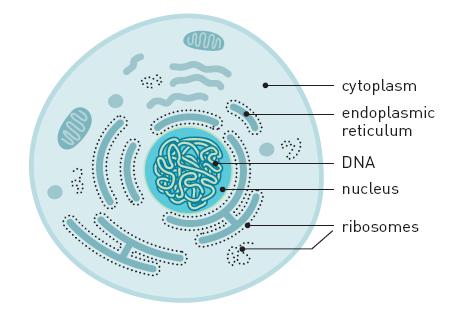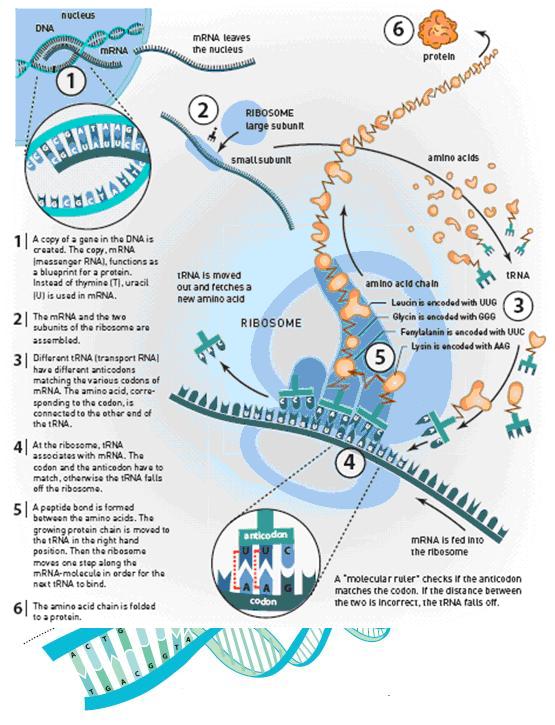The continuation of the popular review (part two of four) including the background to the decision of the Nobel Prize Committee in Chemistry to award the prize to the discoverers of ribosomes, including Prof. Ada Yonat from the Weizmann Institute

R.N.A. - a relative of D. N. A.
While Watson and Crick were making their important discovery, the scientific community became increasingly interested in another nucleic acid, found mainly in the cytoplasm (the cell fluid outside the nucleus). It has been known for a long time that DNA There is a "relative" called R.N.A. which also contains four different nucleotides. However, instead of thyme, found in D.N.A., in B.N.A. There is the nucleotide uracil (uracil, U). In the early fifties, scientists realized that most of the amount of RNA found in small bodies in the cytoplasm (Figure 2).
And more importantly, the scientists discovered that this is the location where the proteins are made. In 1958, they named the protein-producing body a ribosome. It contains proteins and RNA fragments. (ribosomal RNA, rRNA).
.
Decoding the genetic code
Thus, a hundred years after the birth of Darwin's theory of evolution, scientists identified DNA. As a female that preserves within her the traits of heredity. The sequence of nucleotides controls the sequence of amino acids in proteins, which are produced in the ribosomes found in the cytoplasm. However, what is the connection between DNA And the ribosomes? They are located on different sides of the nuclear envelope and lack any direct connection with each other.
The answer to this question was given in the early sixties. Scientists realized that the genetic message is copied into an RNA fragment. They called this isolate R.N.A. Messenger (messenger RNA, mRNA). This protein exits the cell nucleus and reaches the ribosome, where it is used as a replication template (as a glopa) to produce proteins. When these findings became known, scientists were soon able to activate the genetic code with the help of RNA. An artificial messenger and ribosomes in experiments conducted in vitro. The ribosome reads the nucleotides in the N.A. Messenger in triplets, or as they are called "codons" (Wikipedia entry). The first codon discovered to scientists was UUU, which is translated by the ribosome into the amino acid phenylalanine. There are sixty-four different codons corresponding to twenty different amino acids, so some of the amino acids are encoded by more than one codon.
The reading itself is performed by a separate R.N.A. another, known as "R.N.A. Transferring”, tRNA (Wikipedia entry). At one end of this fragment there is an anticodon that binds to the corresponding codon in the RNA fragment. A messenger in the ribosome. At its other end is the amino acid corresponding to the codon.
This is how a picture of the most basic process of life became clear to her: the route in which information flows from DNA. to R.N.A. and turns into enzymes and other proteins. At the same time, the resulting picture was still quite general. As Watson himself put it in an article he published in 1964: "Unfortunately, we will not be able to accurately describe on a chemical level how froda works unless we first know what its structure is." It will not take long, until the year 2000, until someone presents a structure showing how the atoms are located inside the ribosome.

For the first part of the review - from Darwin to Watson and Crick
Tomorrow - the third part - the bacteria from the Dead Sea - about Prof. Ada Yonat's research
For the source of the review on the Nobel Prize website
More of the topic in Hayadan:
- The work of Prof. Yonat made it possible to understand the mode of action of five antibiotic drugs
- Ada Yonat won the 2009 Nobel Prize in Chemistry
- For an interview with Ada Yonat that was published in Scientific American about a year ago - polar bears and drunken ribosomes
- The ribosome cracker - an interview for the Weizmann Institute magazine
- The mysteries of the peptide bond - Weizmann Institute magazine

4 תגובות
Excellent explanation! hook.